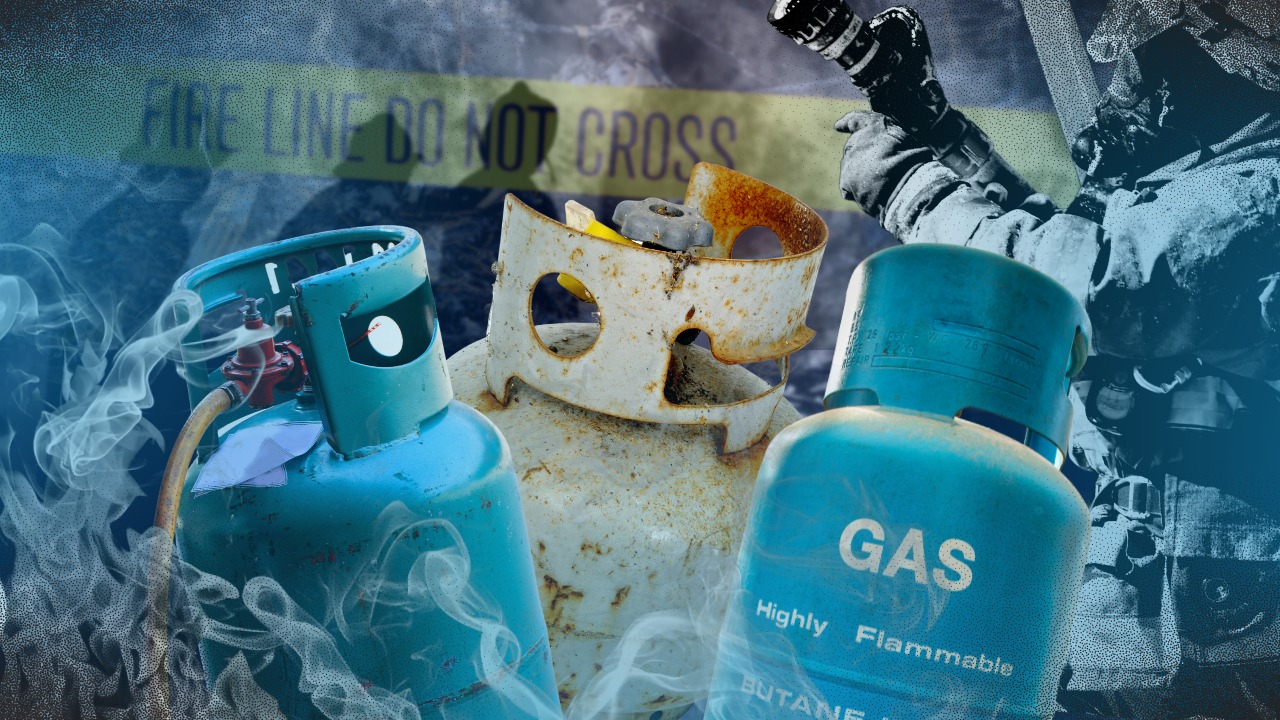
INQUIRER FILE PHOTOS/JEROME CRISTOBAL
MANILA, Philippines—In the Philippines, fires and explosions occur each year due to substandard liquefied petroleum gas (LPG) tanks and gas leaks.
Data from the Bureau of Fire Protection (BFP) showed that there were at least 104 LPG-related fires in 2018. There were 95 fires in 2019 caused by LPG. At least 85 were reported in 2020 and 47 in 2021.
Last year, three cases of LPG tank explosions were recorded. The first one was in March, when an LPG tank leak led to a fiery explosion in a residential area in Cainta, Rizal. It was followed by another explosion in April, which injured two persons in Pateros.
GRAPHIC Ed Lustan
The other explosion occurred in a local government-owned mall in Pagadian City.
READ: Explosion rocks Pagadian City mall
According to the LPG Industry Association Inc. (LPGIA), most LPG-related fires and explosions involve illegally refilled LPG tanks and substandard and dangerous LPG cylinders.
Avoiding hazardous illegal LPG tanks
To avoid similar dangerous accidents this year, LPGIA—citing Republic Act (RA) No. 11592—warned the public of the hazards of purchasing and using illegally refilled LPG cylinders.
RA 11592, or the LPG Industry Regulation Act, signed by then President Rodrigo Duterte in 2021, “aims to establish safe operations of LPG and LPG tanks to ensure the safety and welfare of consumers,” LPGIA said.
READ: Duterte signs LPG bill into law
According to the law, illegally refilled LPG cylinders refer to:
- LPG pressure vessels that are filled or refilled with products or substances other than LPG to achieve the correct net weight
- LPG cylinders filled or refilled directly from LPG bulk storage tank trucks
- LPG cylinders that are refilled through unauthorized cross-filling
- LPG cylinders that are refilled using other LPG cylinders
- LPG cylinders that are refilled outside licensed LPG refilling plants
- Refilling of LPG cylinders that are (1) bearing defaced, tampered, or illegible markings, (2) noncompliant with the Philippine National Standard (PNS) (3) due for repair, re-qualification or scrapping or are subject to a recall or prohibition order of the Department of Energy (DOE) or Department of Trade and Industry (DTI) and those by auto-LPG dispensing stations.
LPGIA encouraged consumers to source only from government-compliant and licensed LPG dealers and retail outlets. It also advised the public to inspect LPG tank quality and check whether the tank’s seals are genuine or untampered.
GRAPHIC Ed Lustan
LPG tanks should be transported through vehicles with permits and clearances from the Land Transportation Office (LTO) and the BFP. The vehicles should also be open and durable enough to allow tank stacking in an upright position.
To verify the legitimacy of the dealer, LPGIA told consumers to ask for necessary permits, including licenses to operate (from the DOE), DTI certificates and licenses, and documents from suppliers indicating that the dealer is authorized to carry LPG brands.
Punishable by law
The law, according to LPGIA, strictly prohibits certain practices with corresponding serious penalties.
“The punishable practices include refilling LPG tanks without authority from the brand owner, usage and possession of fake LPG seals, and refilling and selling generic, defective, and substandard LPG tanks.”
READ: NBI-7 shuts down illegal butane refilling station in Moalboal
According to a provision in RA 11592, the punishment and penalties for illegal refilling of LPG pressure vessels are:
First offense
- Fine of P25,000 for every LPG pressure vessel, or seal and confiscation of these
- Fine of P1,000 for every LPG cylinder in case of broken seals
- Upon conviction, criminal penalty of imprisonment for 6-12 years.
Second offense
- Fine of P50,000 for every LPG pressure vessel or seal, confiscation of these and suspension of license to operate
- Upon conviction, criminal penalty of imprisonment for at least 1 year but not more than 3 years
- Fine of P4,000 for every LPG cylinder in case of broken seals
- Upon conviction, in the case of illegal refilling, criminal penalty of imprisonment for 6-12 years.
Third offense
- Fine of P100,000 for every LPG pressure vessel or seal, closure, and permanent prohibition from the LPG trade
- Upon conviction, criminal penalty of imprisonment of at least 3 years and 1 day but no more than 6 years
- Fine of P8,000 for every LPG cylinder in case of broken seals
- Upon conviction, in the case of illegal refilling, criminal penalty of imprisonment for 6-12 years.
Safety tips, leakage do’s and dont’s
In case of LPG leakage, the DOE reminded the public to do the following:
- Open all doors and windows fully.
- If possible, switch off the regulator (if it is in the on position).
- If leakage is from the valve, immediately put the safety cap in.
- Take the cylinder in an open area and contact the distributor or emergency service.
The energy department strongly advised against switching on or off any electrical equipment inside the house and lighting matches, lighter, and stove to prevent fire or explosions.
GRAPHIC Ed Lustan
As an added precautionary measure, one way to test leaks is to wipe the LPG tank’s hose and valve using a sponge with soap. According to the BFP, an indication that there is a leak is when bubbles form in the area where the soap was applied.
The BFP also suggested cleaning LPG tanks at least once a week to remove residual oils that attract mice, which could puncture the tank’s hose.